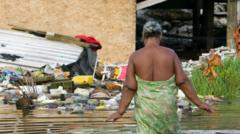**More than 1,500 individuals have sought medical attention as a sandstorm enveloped Iraq, highlighting the nation's increasing vulnerability to climate change.**
**Iraq's Health Crisis: Thousands Affected by Latest Sandstorm**

**Iraq's Health Crisis: Thousands Affected by Latest Sandstorm**
**Severe dust storm exacerbates respiratory issues across Iraq, prompting health emergencies and flight suspensions.**
The recent sandstorm that swept across the central and southern regions of Iraq has left over a thousand individuals grappling with breathing difficulties, according to health authorities. In Muthanna province alone, officials reported at least 700 cases of suffocation, reflecting the severity of the situation. The sandstorm created a dense orange cloud that not only obscured visibility but also led to widespread flight cancellations and power outages in various locales.
Footage circulating on social media shows streets and cities immersed in an unnatural haze, prompting pedestrians and law enforcement to don face masks for protection. Emergency responders have mobilized to aid those struggling to breathe, with hospitals in Muthanna receiving significant numbers of patients. Reports indicate over 250 individuals were treated in Najaf province, while Diwaniyah province saw at least 322 cases primarily involving children. Furthermore, Dhi Qar and Basra provinces recorded an alarming 530 reports of respiratory complications.
The visibility in the hardest-hit areas dipped to less than one kilometer (approximately 0.62 miles) due to the storm's intensity, contributing to the disruption of transportation services including airport operations in both Najaf and Basra. While local weather forecasts indicate improvements are likely by Tuesday morning, the environmental implications remain grave.
The United Nations has identified Iraq as one of the five countries most susceptible to climate change issues, including recurrent sandstorms, extreme temperatures, and water shortages. The Ministry of Environment has issued warnings about the increasing frequency of "dust days" in Iraq, predicting that this severe weather will likely persist. A devastating sandstorm last year resulted in one fatality and left thousands needing medical care for respiratory ailments, underscoring the public health crisis that adverse climatic conditions can provoke.
Footage circulating on social media shows streets and cities immersed in an unnatural haze, prompting pedestrians and law enforcement to don face masks for protection. Emergency responders have mobilized to aid those struggling to breathe, with hospitals in Muthanna receiving significant numbers of patients. Reports indicate over 250 individuals were treated in Najaf province, while Diwaniyah province saw at least 322 cases primarily involving children. Furthermore, Dhi Qar and Basra provinces recorded an alarming 530 reports of respiratory complications.
The visibility in the hardest-hit areas dipped to less than one kilometer (approximately 0.62 miles) due to the storm's intensity, contributing to the disruption of transportation services including airport operations in both Najaf and Basra. While local weather forecasts indicate improvements are likely by Tuesday morning, the environmental implications remain grave.
The United Nations has identified Iraq as one of the five countries most susceptible to climate change issues, including recurrent sandstorms, extreme temperatures, and water shortages. The Ministry of Environment has issued warnings about the increasing frequency of "dust days" in Iraq, predicting that this severe weather will likely persist. A devastating sandstorm last year resulted in one fatality and left thousands needing medical care for respiratory ailments, underscoring the public health crisis that adverse climatic conditions can provoke.



















